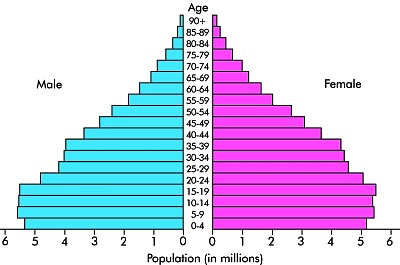The population pyramid for Mexico in 2010 is shown below:
What does this pyramid tell us about Mexico’s population and possible future trends?
The number of babies born during the last 20 years has been more or less equal for each 5-year period. This is despite a higher number of females in the age-bearing categories (15-45). These two statements, taken together, must imply that both birth rates (number of births/1,000 people) and fertility rates (number of children per female of child-bearing age) have fallen and continue to fall.
There are numerous implications for a population with a declining number of babies. Perhaps the most obvious is that fewer school places will be required in ten years time than are currently needed. In Mexico’s case, it is unlikely that school buildings will be closed (at least not in the short to mid-term) since many government-run schools currently house two independent school populations, one attending classes every morning, and the other attending classes in the afternoons.
The decline in babies also means that the average age of Mexico’s population continues to rise. The median age of Mexico’s 112.3 million inhabitants is now 26 years (i.e. half the population is older than 26 years, the other half is 26 years or younger).
Several chapters of Geo-Mexico: the geography and dynamics of modern Mexico discuss additional insights into Mexico’s population dynamics and trends, and their implications for future development. An earlier post here includes a link to a pdf file showing Mexico’s population pyramid in 1990, and the predicted pyramid for 2050. The 2050 pyramid shows just how fast Mexico’s population will age if present trends continue.

Sorry, the comment form is closed at this time.